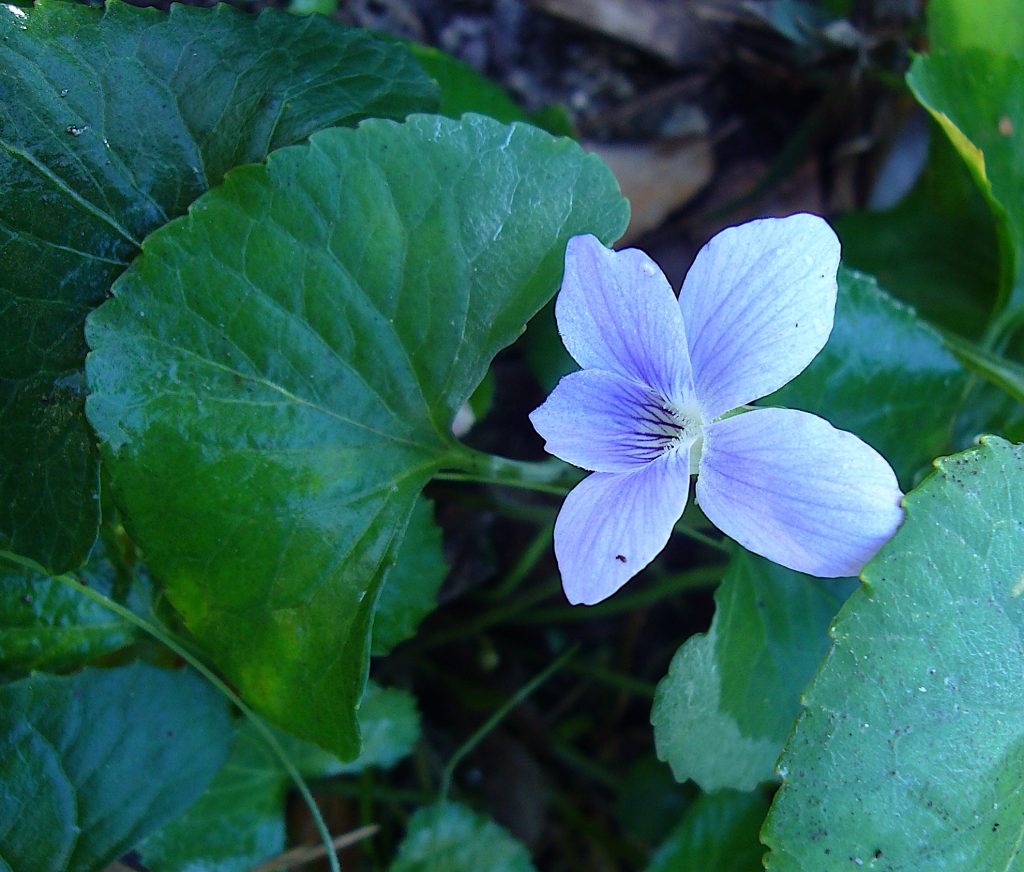
Violet leaves, stems and blossoms are edible but not the roots. Photo by Green Deane
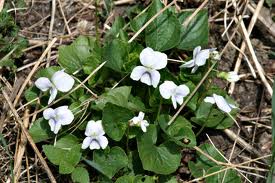
All Violets in the genus Viola are edible.
It’s cultivated brethren is the pansy. There’s a huge variety of violets in North America ranging from field pansies to those that like to grow down hill from the septic tank. Whether wild or cultivated violets are attractive, personable blossoms, usually on the sweet, viscous side. There are a couple of precautions, however. The first is to make sure the soil they are in — either a pot or bed — is wholesome and that the water they are getting is good. If they come from a garden center they might have pesticides on them. The other precaution is a bit more esoteric: Yellow blossoms tend to have a laxative effect. We saw these violets during out foraging class in Jacksonville this past weekend. You can read about violets here. I have a video about them here.
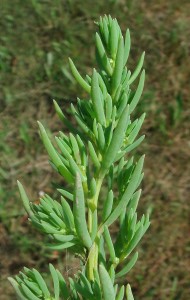
Seablite is related to Lamb’s Quarters. Photo by Green Deane
If you could choose one wild plant to become a commercial product, what would it be? Many people have tried to make Poke Weed (Phytolacca americana) a green in your local grocery but toxicity and the required two-boilings has always plagued its commercialization. The Ground Nut (Apios americana) was one of the original exports from colonial America but it has at least a two-year growth cycle. Louisiana State University (1984-96) developed a commercial variety but the program disappeared when the professor-in-charge, Bill Blackmon, changed colleges. In 1962 Professor Julia Morton of the University of Miami recommended Spanish Needles (Bidens pilosa) become a commercial product. Nearly 60 years later that hasn’t happened, perhaps because of flavor or the fact it can grow almost anywhere as a weed. My candidate would be Suaeda linearis, Sea Blite. It is just starting its seasonal run. We saw a lot of small plants at Ft. Desoto this last weekend. Sea Blite has everything going for it except perhaps for its name. It’s mild but tasty, has excellent texture, can be eaten raw or cooked though cooked is the usual way. The plant is nutritious, stores well, looks good, easily grows in salty ground (read unused land) and even feels good to handle. About the only downside, for me, is that I have to drive to either coast to get some. I need to introduce it to my garden. Think of Sea Blite as a Chinopodium that likes to grow in salty places, either near the ocean or salt licks. It has a high sodium content but boiling reduces that significantly. If you live anywhere near the ocean or inland salty areas, now and the next few months is the time to go looking for seablight and seepweeds. To read more about Sea Blite click here. To watch my video go here.
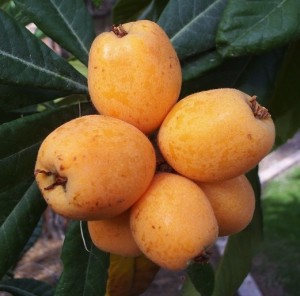
Loquats actually have a small amount of arsenic in them. Photo by Green Deane
An imported and naturalized tree that is fruiting now is Loquat. I’ve seen several trees heavy with fruit It’s a very common backyard fruit tree that has liberated itself into the local landscape. Most of the Loquats fruit in the spring but there is a variation that fruits in the fall, not common but one sees it now and then. Commonly called the “Japanese Plum” it is not a plum nor is it from Japan. The fruit is edible from tart yellow to sweet yellow. The green fruit is toxic particularly to children. With seeds removed then dry well and can also be made into a nice, soft wine. You can read about the Loquat here. I have a video here.
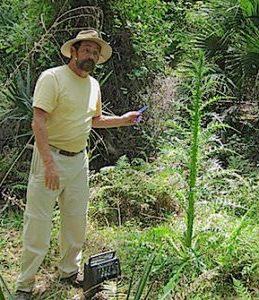
Foraging classes are held rain, shine, hot or cold. Photo by Nermina Krenata
I’ve had several questions asking whether my classes will go on. The answer is yes with some qualifiers. If a park is closed or if we are under travel bans no. Otherwise yes. On the positive side we are outside — getting vitamin D — classes are small, usually less than 10, and we don’t have to stand next to each other (I have a portable PA system.) Basically as long as the park is open we will have the class. I will monitor for closings and will keep you informed. I have one class this weekend in Melbourne with some people already signed up.
Sunday, March 22nd, Wickham Park, 2500 Parkway Drive, Melbourne, FL 32935-2335. Meet at the “dog park” inside the park. 9 a.m. to noon.
Saturday, March 28th, Haulover Canal, Merritt Island National Refuge, north of the Kennedy Space Center. Read the instructions below. We meet the the northwest end of the canal area. Nine to noon. As this is federal property we will have to monitor it for closure.
Sunday, March 29th, Spruce Creek Park, 6250 Ridgewood Ave. Port Orange FL, meet at the pavilion. 9 a.m. to noon.
Saturday, April 4th, Bayshore Live Oak Park, Port Charlotte, FL, 9 a.m. to noon. Meet at the parking lot at the intersection of Bayshore Road and Ganyard Street.
Sunday, April 5th, Mead Gardens, 1500 S. Denning Dr., Winter Park, FL 32789. 9 a.m. to noon. Meet to the right (east) of the Bartram sign. (Don’t confuse this location with Ft. Mead which is 80 miles further south.)
For more information. to sign up for a class or to pre-pay go here.
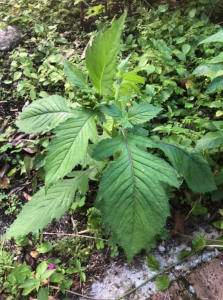
Redflower Ragleaf. Photo by Carlos Recco.
One of the more interesting aspects of foraging in Florida (or Hawaii) is tropical imports that are edible. One finds or learns about new ones two or three times a year. This is one of those times and my thanks for Carlos Recco for bringing it to my attention: Redflower Ragleaf. It resembles a cross between Burnweed and a red-blossomed Florida Tassel Flower. Botanically Crassocephalum crepidioides, the USDA lists it a being found in only three counties in the US, basically southeast Florida: Broward, Dade, and Monroe. Wonderlin says it’s an “occasional” in central and southern penninsula Florida. The species is native to tropical Africa and is here all year. Cornucopia II says on page 37: Ebolo, Okinawan Spinach, young leaves and shoots are used as a potherb fried or mixed in Khaao yam. The leaves are fleshy, tinged with purple, and have a somewhat mucilaginous quality and nutty flavor. Has become quite popular on the island of Okinawa and in Hawaii. In Thailand, the roots are eaten with chili sauce or cooked in fish curry. “
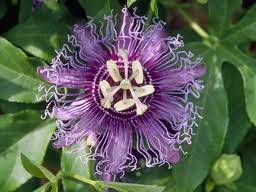
Maypop blossoms are also edible. Photo by Green Deane
On a 30-mile bike ride today I saw a few edibles worth mentioning. Red Mulberries are putting on young, green fruit. Young leaves are edible cooked. The unripe green fruit is mildly mind-altering but will upset the stomach. Try not to eat them. Also seen along the bike trail are blossoming Blackberries. There are two kinds of Blackberries locally, those that grow canes and those that crawl along the ground. Both produce edible fruit. Also noticed along the trail are Maypops. They are not unusual, in fact very common. But until they get a foot long or so they grow upright and look like a vertical plant. Somewhere between 12 and 15 inches tall the plant keels over and becomes the familiar vine that can grow a hundred feet long. And if one looks closely here and there one can also find ripe Creeping Cucumbers .
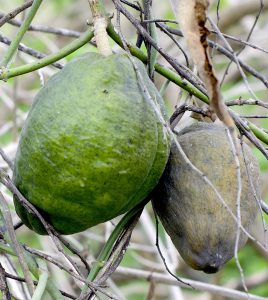
Fruit of the Latex Strangler Vine. Photo by Green Deane
Another find this past weekend at Ft. Desoto was Latex Strangler Vine. At one time a bane of the citrus industry the lengthy vine grows edible fruit that is high in vitamin C. It’s called “Strangler” because it can cover a citrus tree shading it out and killing it. The specie was “found” twice in Florida some twenty-five years apart in the last century. The state unsuccessfully spent millions trying to get rid of it Look for it on fences and around current or old citrus groves. Decades ago when the weather was warmer the vine was common wherever there was citrus. Cooler weather has frozen it and citrus out on the north end of the state. I have seen Latex Strangler Vine in Ocala and near Gainesville but that’s the limit. In both cases the plants were under Live Oaks and in unmowed areas. It is quite common mid-state and south. The blossoms are edible off the vine. The raw leaves can also be eaten but are usually dipped in oil first. Read the above article. I also have a video on the species here.

Green Deane Forum
Want to identify a plant? Perhaps you’re looking for a foraging reference? You might have a UFO, an Unidentified Flowering Object, you want identified. On the Green Deane Forum we — including Green Deane and others from around the world — chat about foraging all year. And it’s not just about warm-weather plants or just North American flora. Many nations share common weeds so there’s a lot to talk. There’s also more than weeds. The reference section has information for foraging around the world. There are also articles on food preservation, forgotten skills from making bows to fermenting food. Several hard-to-find books are there page for page. Recent posts this week include Spring 2020 Plantings, Light Purple Flowers and Fuzzy Leaves, Red Blossoms Hanging Down, Edible Privacy Fence, Tendrilizing, Calculating COVID-19 Mortality Rate, Nettle Spanakopita, Pawpaws Starting Early? What are those White Blossoms, Brazilian Pepper Revisited, Palmer Amaranth, In The Loop, Tomatoes: A Fruit First, a Vegetable Second, and Butterweed: Annual Warning. You can join the Forum by going to the upper right hand top of this page.
 Donations to upgrade EatTheWeeds.com have gone well. Thank you to all who have contributed to either via the Go Fund Me link, the PayPal donation link or by writing to Green Deane POB 941793 Maitland FL, 32794. There are many needs left such as expanding the foraging teacher page and the page on monotypic edibles. There’s always something and such things get more complex and expensive every year.
Donations to upgrade EatTheWeeds.com have gone well. Thank you to all who have contributed to either via the Go Fund Me link, the PayPal donation link or by writing to Green Deane POB 941793 Maitland FL, 32794. There are many needs left such as expanding the foraging teacher page and the page on monotypic edibles. There’s always something and such things get more complex and expensive every year.

Foraging DVDs make a good gift to watch during the lifeless months of winter.
Though your foraging may drop off during Covid-19 travel bans but it’s a great time to study wild edibles with my nine DVD set. Each DVDs has 15 videos for 135 in all. They make a great gift. Order today. Some of these videos are of better quality than my free ones on the Internet. They are the same videos but many people like to have their own copy. I burn and compile the sets myself so if you have any issues I handle them personally. There are no middle foragers. And I’m working on adding a tenth DVD. To learn more about the DVDs or to order them click here.
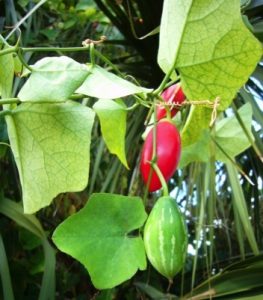
Ivy Gourd fruit ripens to red. Photo by Green Deane
One more thing: While outside in the back yard today to get some extra vitamin D I noticed my Ivy Gourd is fruiting. It’s a vegetable that has champions and haters. If you are a gardener or a permaculturist it’s an excellent species. The plant is an annual, fruits heavily, can be eaten at two different stages (cucumber green and sweet pepper red) and is very resistant to fungus and infestations. If you are a native plant advocate you oppose most if not all “invasive” species. Ivy Gourd is listed as said. I don’t find it too often mid-state and have not seen it elsewhere in the state so I am not too sure how invasive it is. The USDA lists it only in two counties in Florida but I know it is in at least three. To read more about Ivy Gourd go here, video here.
This is weekly newsletter 397, If you want to subscribe to this free newsletter you can find the sign-up form in the menu at the top of the page.
To donate to the Green Deane Newsletter click here.
Seeing these blossoms around? Leave them alone. This tree can make you sick or kill you. It’s the Laurel Cherry, toxic leaves, toxic fruit, toxic seeds, toxic bark. Just say no.
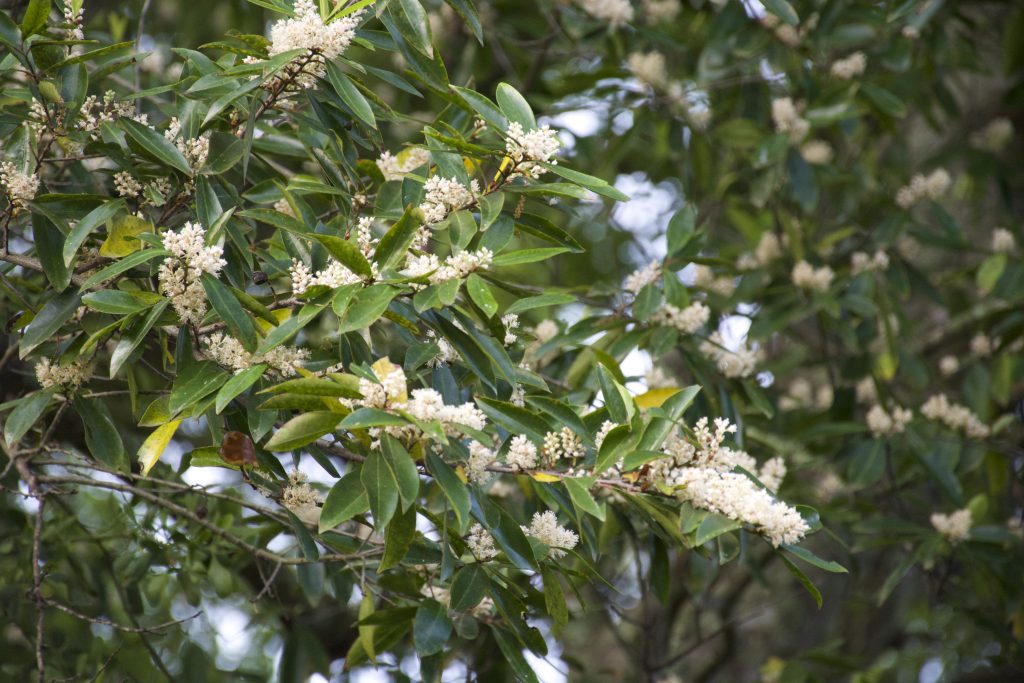


Gynura bicolor is also called okinawa spinach, ebolo and a few other of the same names. I don’t think it is the same. It is very easy to propagate and grows in neutral soil, so you may need to fix the pH. If you fiddle with it a bit (weaving in the ends) and eat your trimmings, you can make a lovely low border hedge out of it. The smaller leaves on the tips are quite good and taste like spinach. I just want know if it is a close cousin or something very different.